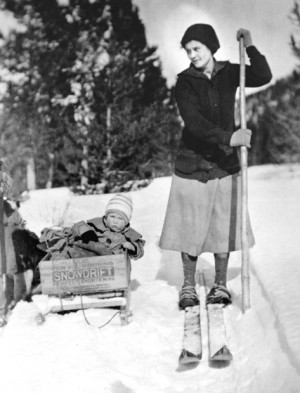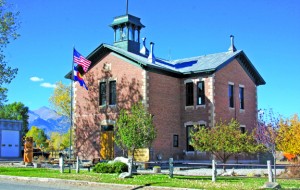By George Sibley
Cruising into election time, I find myself thinking about wolves. And fear.
I have been following, in a layman’s way, the wolf restoration project in the northern Rockies. One thing I’ve learned is that wolf restoration is credited with restoring the unraveling valley ecosystem in and around Yellowstone National Park. Without going into details, this is mainly due to the way the wolves have shaped the elk herds. Without the wolves, their main natural predator, the elk had not only over-populated the valleys, but had also become fat and lazy “meadow potatoes” (Dave Foreman’s term), loafing around the valley floors trashing the vegetation foundation to any ecosystem.
Now the restored wolves keep the elk bunched up for safety in numbers and on the move. The wolves constantly prowling around the edges, trying to separate from the herd the old, infirm, ejected or just stupid individuals, pushes the herd around so it is no longer able to stay in place long enough to devastate vegetation.
Ecologist Cristina Eisenberg, who studies wolves up around the U.S.–Canada border where our Glacier National Park merges with Canada’s Waterton National Park, calls this ecologically healthy situation an “ecology of fear” (The Wolf’s Tooth). For the ecosystem to stay healthy, its large herbivores have to be kept in a relatively constant state of restless and nervous anxiety. Western rangeland ecologist, Allan Savory, observed the same thing as a wildlife biologist in Africa, watching the great grazing herds there being harassed by predator packs. One could induce that this “ecology of fear” is a global thing. Grazed ecosystems everywhere depend for their health on predator packs keeping herd animals in constant chronic states of anxiety. Give the herds “freedom from fear” (one of our basic “four freedoms”), and they turn into meadow potatoes devouring their own environment.
As a shameless exploiter of metaphors I, of course, begin to wonder where the human species fits into this picture – working backward from the fact that there seems to be a lot of intentional effort today to keep Americans in a constant state of “level orange” anxiety. We hear from our leaders that we are the greatest nation on earth, yet as individuals in this great nation we are constantly encouraged to be anxious and fearful of just about everything. There’s the biggie, global terrorism, which came along just in time to replace the disappeared global communism. Terrorist fear is now mixed up with the fear of all immigrants (out to get our jobs or our lives). There’s a new flu every year to fear; there are strangers and drug dealers eyeing our children. There are hackers trying to get into our bank accounts – etcetera. Then there are the more abstract things that we are supposed to fear, including socialism, Muslimism, and deficit spending.
But wait a minute. To try to fit all this cultural fear into an “ecology of fear” theory and would we have to see ourselves as … herd animals? Us? Homo sapiens? The planet’s top predator? Rugged individualists all?
But really, don’t the majority of us Americans today behave more like herd animals than our ancient ancestors who were the greatest herd-predators ever? We have been thoroughly trained and indoctrinated to be herdable from a fairly early age. Education critics such as Theodore Sizer and Neil Postman point out that the main lessons in public schooling are life skills like getting in line, being on time and not asking difficult questions.
Much of our herd behavior is actually just straightforward management necessity, the unavoidable social contract of a concentrated society of millions. We have to all stop at “stop” signs, we have to all drive on the same side of the highway, we have to stand in lines for things we are supposed to want because if we don’t, the situation will result in Hobbesian chaos. Our hunter-predator ancestors wandered the earth in bands of twenty or thirty humans. Certainly they had problems, but the only large masses they had to manage were the herds they fed on.
There are, however, more insidious aspects to being cultivated as herd animals, having to do with “the fear factor” that seems to now be part of our culture. You and I, of course (being Central Coloradans), may not be anxious or afraid about the things designed to keep the herd in a perpetual nervous and anxious state. But we still take off our shoes at the “security gate” (glad we don’t – yet – have to “drop trou”) for the simple reason that we know if we were to assert a personal belief that the shoe business is more about exercising authority than maintaining security (which I believe it is), then we would not be allowed onto the airplane; and if we made too much of an issue, we would lose our freedom, which is to say, lose the privilege of continuing to be herded with the rest of the herd.
But if the mass of us is an increasingly well-managed herd, how are we managed? And by whom, or what? It’s not wolves, at least not in the literal sense. But … this whole discussion was actually aired ninety years ago, around 1920, by Walter Lippman, an American journalist who thought so much more than journalists usually do that he became something of a philosopher.
Lippmann not only used the “herd” metaphor, he went a step further and called us a “bewildered herd.” He presented a paradox. He first echoed Washington and Jefferson, saying it was impossible to have a democracy if the people did not know what was going on. But then he pointed out that modern society is so complex, multi-faceted and just plain huge that it is impossible for any individual member of the society to have a complete picture of what is going on. So in order to run a democratic society with millions of people, it is necessary for the society to have managers to “manufacture” a common sense of reality for the people, in order to get the people’s consent to do what the managers want to do.
But who are these managers? According to Lippman, they are elite groups of “professionals,” such as management professionals, legal professionals, economics professionals, education professionals, and (a new class that he hoped would replace the Hearstian yellow journalists) media professionals, among others. Together these elites would construct and disseminate (the journalistic elite’s job) a common picture of reality for the otherwise “bewildered herd” and the herd would then democratically provide the consent necessary to address that picture of reality. “Most people,” Lippman said (in Public Opinion, his most important book), “must have the world summarized for them by the well-informed, and will then act accordingly.” (Think “weapons of mass destruction.”)
One hopes, of course, that those self-elected elites “have the best interests of the society at heart,” whatever that means. Today it seems to just mean increasingly unsubtle variations on “whatever is good for General Motors, Citibank, Halliburton, whichever, is what’s good for the United States.”
Lippman never, to the best of my knowledge, used the “predator” metaphor in his discussion of herd management. But, here on this election eve, at the end of a solid decade of all-out fear-mongering based on exaggerations, obfuscations and outright lies of the most shameless sort, by “elites” that can only be seen as self-serving, all served up with a semi-straight face by the elite media, one wants to ask if our managerial elites might be on the predatory side. The most ominous development is the way management is nudging the most fearful to armed aggression against their management-induced fears. “Don’t retreat – reload” rhetoric is rewarded with wide publicity. The media elite are doing their utmost to elect those Tea Partiers, building a fear-driven brownshirt fringe into a movement.
So one wonders, might we be bifurcating into a dualistic culture, part of us a predatory class feeding off of a bewildered herd made up of the rest of us? Someone coined the term “The Billionaire Boys Club” for the economic elite that has effectively bought up or bought out all the other elites, including Lippman’s media elite. Are the boy billionaires nice well-meaning people?
Another question that arises from the wolf parallel, is all this fear they are using to manufacture our consent for whatever they want to do, is it at least improving our ecosystem? Or some system? Something? That’s the trade-off the elk get for living in constant anxiety. What do we get? There have been efforts to get us stirred up and anxious about various environmental concerns (climate change, soil loss, peak oil, etc.), but they haven’t managed to make the cultural big time as fear factors – too inconvenient to the boy billionaires.
A wonderful poster is floating through the internet. It’s the old “I want YOU” Uncle-Sam character saying, “I want YOU to stop being AFRAID of other Americans, of other religions, of other classes, of speaking out. You’re Americans first. Act like it! (If you don’t get it, ask an American who does.)” I love that. I want to live it, and usually think I’m trying to, and so probably do many of the readers of this journal. But, it doesn’t seem to make much difference. And, when has a herd ever kicked ass on its predators?
George Sibley was born in Western Pennsylvania, but was conceived in Colorado by Colorado natives, and thus considers himself to be a native Coloradan.

